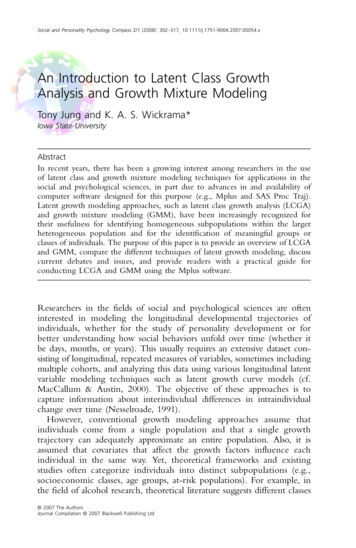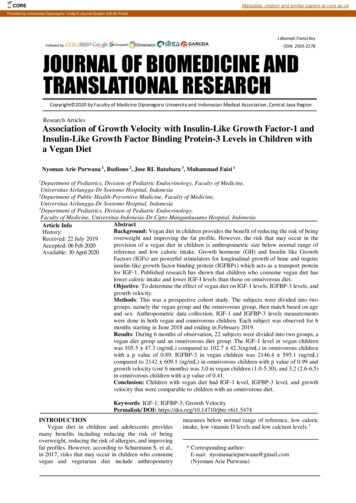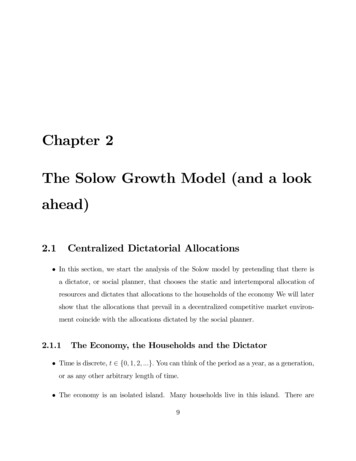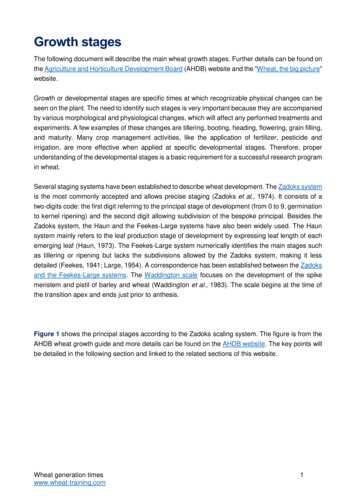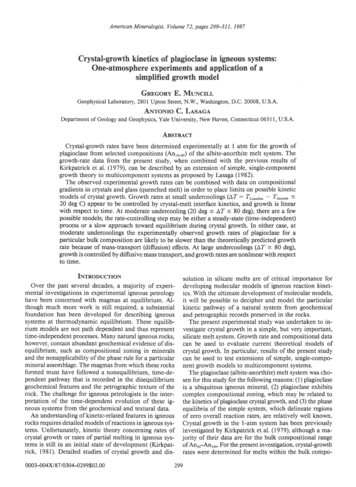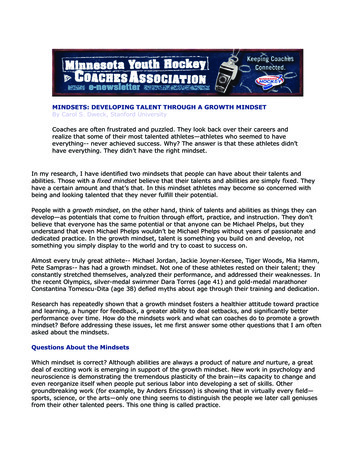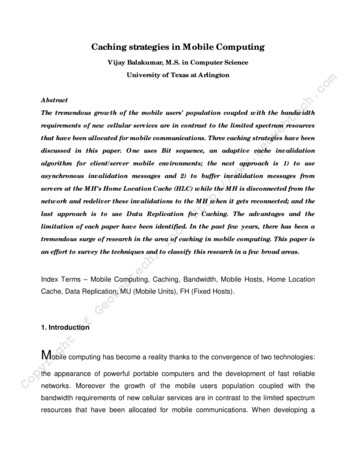
Transcription
Caching strategies in Mobile ComputingVijay Balakumar, M.S. in Computer Sciencetech.comUniversity of Texas at ArlingtonAbstractThe tremendous growth of the mobile users' population coupled with the bandwidtheowebrequirements of new cellular services are in contrast to the limited spectrum resourcesthat have been allocated for mobile communications. Three caching strategies have beenww.gdiscussed in this paper. One uses Bit sequence, an adaptive cache invalidationalgorithm for client/server mobile environments; the next approach is 1) to use/wasynchronous invalidation messages and 2) to buffer invalidation messages fromtp:/servers at the MH’s Home Location Cache (HLC) while the MH is disconnected from theHtnetwork and redeliver these invalidations to the MH when it gets reconnected; and thelast approach is to use Data Replication for Caching. The advantages and thec.limitation of each paper have been identified. In the past few years, there has been aIntremendous surge of research in the area of caching in mobile computing. This paper isbtech,an effort to survey the techniques and to classify this research in a few broad areas.weIndex Terms – Mobile Computing, Caching, Bandwidth, Mobile Hosts, Home LocationofGeoCache, Data Replication, MU (Mobile Units), FH (Fixed Hosts).ght1. IntroductionCopyriMobile computing has become a reality thanks to the convergence of two technologies:the appearance of powerful portable computers and the development of fast reliablenetworks. Moreover the growth of the mobile users population coupled with thebandwidth requirements of new cellular services are in contrast to the limited spectrumresources that have been allocated for mobile communications. When developing a
mobile network’s infrastructure, wasting bandwidth should be avoided because it is verycomcostly. Thus, the objective is to try and get the most out of the minimum infrastructure.Caching can reduce the bandwidth requirement in a wireless computingtech.environment as well as minimize the energy consumption of wireless portablecomputers. Efficient caching schemes for mobile computing should take into account theeowebfollowing factors: data access pattern and update rates, communication/access costs,mobility pattern of the client, connectivity characteristics and location dependence of thedata. The major problems in mobile computing are 1) Bandwidth considerations andww.gdata transfer rate; 2) Frequent network failures; 3) Limited battery life; 4) Wireless/wcommunication is expensive.:/Among the three techniques, one uses Bit sequence - an adaptive cachetpinvalidation algorithm for client/server mobile environments; the next approach is 1) toHtuse asynchronous invalidation messages and 2) to buffer invalidation messages fromservers at the MH’s Home Location Cache (HLC) while the MH is disconnected from thec.network and redeliver these invalidations to the MH when it gets reconnected. ThisIntechnique is called AS (Asynchronous and Stateful); and the last approach is to useh,Data Replication for Caching. The main purpose of this paper is to describe the threebtecstrategies mentioned above and throw the limitations of those approaches and also putforward the possible research directions on these approaches.weThe rest of the paper is organized as follows: Section 2 describes the bitGeosequence adaptive cache invalidation algorithm. Section 3 describes the informaloverview of the second approach. Section 4 describes the caching strategy using dataofreplication. Section 5 presents the analysis of all the three schemes – their advantages,ghtlimitations and possible future research directions. Finally the conclusions are drawn inCopyriSection 6.2. Bit – Sequence algorithmIn [4] an approach to invalidate cache was provided, where the server periodicallybroadcasts invalidation report in which the changed data items are indicated. Rather
than querying a server directly regarding the validation of cached copies, clients canlisten to these invalidation reports over wireless channels. A major challenge for thiscomapproach is to optimize the organization of broadcast reports. In general a large reportcan provide more information and is more effective for cache invalidation. But a largetech.report also implies a long latency for clients while checking the report, given a limitedbroadcast bandwidth.eowebThe Broadcasting Timestamp(TS)[4] is a good example of an algorithm that limitsthe size of the report by broadcasting the names and timestamps only for the data itemsupdated during a window of w seconds. Effectiveness of the report cannot beww.gguaranteed for clients with unpredictable disconnection time. This approach presents/wthree optimization techniques. They are::/1) For applications where cached data items are changed less often on thetpdatabase server, use the bit-sequence naming technique to reference data itemsHtin the report.2) Instead of including one update timestamp for each data item, use an updatec.aggregation technique to group a set with only one timestamp in the report.In3) A hierarchical structure of bit-sequences technique to link a set of bit sequencesh,so that the structure can be used by the clients with different disconnection times.btecThe algorithm Bit – Sequence(BS) uses these three techniques. This algorithm can beused in applications where frequently cached data items are predictable.weThe bits in the sequence represent those data items in the database that areGeofrequently cached and referenced by a majority of clients. The assumption in this modelis that the database can be only updated by the servers. The database consists of Nofnumbered data items:d1, d2, , dN and is fully replicated at each data server. Eachghtserver periodically broadcasts invalidation reports. To answer a query, the client on aCopyrimobile host listens to the next invalidation report and use that report to concludewhether its cache is valid or not. Invalid caches must be refreshed via a query to theserver.In the Bit – Sequence algorithm three techniques are used to optimize the size ofreport structure while retaining the invalidation effectiveness. To reference data items inthe database a technique called BitSequence naming is applied in the BS algorithm.
The server broadcasts a set of bit sequence. Each bit in a bit sequence represents adata item in the database. For example the nth bit in a size N of sequence representscomdata item dn. This technique can be applied when both client and server agree upon themapping of bits to the names of data items in the server database. The client can findtech.the data item that each bit represents in its cache based on the position of the bit in thesequence. The next technique is update aggregation. In the broadcast report, eacheowebsequence is associated with only one timestamp instead of separate timestamp fo reachitem. A bit “1” in the sequence means that the item represented by the bit has beenupdated since the time specified by the timestamp. A bit “0” means that the item has notww.gbeen updated since the specified time. The update aggregation not only reduces the/wsize of the report, but also decreases the invalidation precision of cache invalidation. To:/adapt to various disconnected clients, a technique called hierarchical structure of bittpsequences is applied.CopyrightofGeowebtech,Inc.HtThe BS algorithm can be explained by using the following example.
Consider a database consisting of 16 data items. Figure 1 shows a Bit-Sequences (BS)structure reported by a server at time 250. Suppose that a client listens to the reportcomafter having slept for 80 time units. That is, the client disconnected at time 170 ( 250 80), which is larger than TS(B2) but less than TS(B1). The client will use B2 totech.invalidate its caches. To locate those items denoted by the two “1” bits in B2, the clientwill check both B3 and B4 sequences, using the following procedure. To locate theeowebsecond bit that is set to “1” in B2, check the position of the second “1” bit in B3. We seethat the second “1” bit in B3 is in the 5th position; therefore, check the position of the 5th“1” bit in B4. Because B4 is the highest sequence and the 5th “1” bit in B4 is in the 8thww.gposition, the client concludes that the 8th data item was updated since time 170.Similarly, the client can deduce that the 12th data item has also been updated since that://wtime. Therefore, both the 8th and 12th data items will be invalidated.tpThe main contributions of this approach include the following:Ht1) When a static bit mapping scheme is implicitly assumed, the BS algorithm canapproach the optimal effectiveness for all data items indicated in the reportc.regardless of the duration of disconnection of the clients. However, suchInoptimization can be achieved only at the cost of about 2 binary bits for each itemh,in the report.btec2) The BS algorithm can also be applied to optimize other broadcast based cacheinvalidation algorithms in which the dynamic bit mapping has to be includedweexplicitly. The optimization reduces the size of the report by about one half whileofGeomaintaining the same level of effectiveness for cache invalidation.ght3. The AS approachCopyriIn this paper, we present a caching scheme for wireless networks which usesasynchronous invalidation reports (callbacks) to maintain cache consistency, i.e., reportsare broadcast by the server only when some data changes and not periodically.Frequent voluntary and involuntary disconnection of clients makes this a very difficultproblem [5], [6], [7]. Each mobile client (host) (MH) maintains its own Home LocationCache (HLC) to deal with the problem of disconnections. The HLC of an MH is
maintained at a designated home Mobile Switching Station (MSS). It has an entry foreach data item cached by the MH and needs to maintain only the time-stamp at whichcomthat data item was last invalidated.h,Inc.Http://www.geowebto a static network. The mobile hosts communicate with the servers viatech.In figure 2, the mobile hosts (MHs) query the database servers that are connectedbtecFigure 2wireless cellular network consisting of mobile switching stations (MSS) and basewestations. A mobile host can be in two modes: awake or sleep. When a mobile host isGeoawake (connected to the server), it can receive messages. Hence, this state includesofboth active and dozing CPU modes. A MH can be disconnected from the network eithervoluntarily or involuntarily. From the perspective of the mobile host's cache, it isghtirrelevant whether the invalidation were delayed due to voluntary disconnection (e.g.,Copyriswitching off the laptop) or involuntary disconnection (e.g., wireless link failure, hand-offdelay). Hence, for our purpose, a disconnected client is in sleep mode; we use the termwakeup to indicate reconnection. The client sends a uplink request (query) for the data itneeds to the database server and the server responds by sending the requested data onthe down-link. In order to minimize the number of uplink requests, the client caches aportion of the database in its local memory. The client-cached data is also referred to as
active data [8]. Caching data at clients necessitates a protocol between the client andthe database server to ensure that the client cache remains consistent with the sharedcomdatabase. The objective of the proposed scheme is to minimize the overhead for theMHs to validate their cache upon reconnection, to allow stateless servers, and totech.minimize the bandwidth requirement. The general approach is to buffer the invalidationmessages at Home Location Cache (HLC) Our caching scheme for the mobileeowebenvironment is based on the following assumptions:1) Whenever any data item is updated anywhere in the network, an invalidationmessage is sent out to all MSS via the wired network; thus, when a mobile host MH isww.groaming, it gets the invalidation message if it is not disconnected (we assume no/wmessage is lost due to communication failure or otherwise in the wired network).:/2) An MH can detect whether or not it is connected to the network.tp3) An MH informs its HLC before it stores (or updates) any data item in its local cache.Ht4) The static host, which is nearest to the MH and maintains the HLC of the MH,Inc.forwards the MH any invalidation it receives from the server.h,Consider an MSS with N mobile hosts (MHi, 1 i N) at any given time. For any i,btecHLCi for MHi, as maintained in the MSS, keeps track of what data has been locallycached at MHi (state information of the MH). In general, HLCi is a list of records (x, T,weinvalid flag) for each data item x locally cached at MHi, where x is the identifier of a dataGeoitem and T is the time-stamp of the last invalidation of x. The key feature of our schemeis that the invalidation reports are transmitted asynchronously and those reports areofbuffered at the MSS (in the HLCs of the mobile hosts) until an explicit acknowledgmentghtis received from the specific MH. The invalid flag (in the HLC record for the specific dataCopyriitem) is set to TRUE for data items for which an invalidation has been sent to the MH butno acknowledgment has been received.Each MH maintains a local cache of data items which it frequently accesses. Beforeanswering any queries from the application, it checks if the requested data is in aconsistent state. We use call-backs from a MSS to achieve this goal. When a MSS
receives invalidation from a server, the MSS determines the set of MHs that are usingthe data by consulting the HLCs and sends an invalidation report to each of them. Whencoma MH receives that invalidation message, it marks the particular data item in its localcache to be invalid. When an MH receives (from the application layer) a query for a datatech.item, it checks the validity of the item in its local cache. If the item is valid, it satisfies thequery from its local cache and saves on latency, bandwidth and battery power;eowebotherwise, an uplink request to the MSS for the data item is required.In sleep mode, a mobile client is unable to receive any invalidation messages sent to itww.gby its HLC. We use the following time-stamp based scheme by which the MA can decide/wwhich invalidations it needs to retransmit to the mobile host. Each client maintains a:/time-stamp for its cache called the cache time-stamp. Cache time-stamp of a cache istpthe time-stamp of the last message received by the MH from its MA. The client includesHtthe cache time-stamp in all its communications with the MA. The MA uses the cachetimestamp for two purposes:c.1. To discard invalidations it no longer needs to keep, andCopyrightofGeowebtech,In2. To decide the invalidations it needs to resend to the client.Figure 3Consider the example scenario shown in Fig. 3. Initially, the cache time-stamp ofthe MH is t0 and MH's cache has two data items with ids x and z. When MSS receivesan invalidation message notifying it that x has changed at the server at time t1, it addsthe invalidation message to MH's HLC and also forwards the invalidation message to the
MH with (data-item id, time-stamp), i.e., .x; t1. On receiving the invalidation messagefrom the MSS, the MH updates its cache time-stamp to t1 and deletes data item x fromcomits cache. Later, when MH wants to access y, it sends a data request with .y; t1. to theMSS. In response to the data request, the MSS fetches and forwards data itemtech.associated with y to the MH and adds .y; t2. to the MH's HLC, where t2 is the lastupdates time-stamp provided by the data server. The MH updates its time-stamp to t2eoweband adds y to its cache. Now, suppose MH gets disconnected from the network and theinvalidation message for y is lost due to this disconnection. When MH wakes up, itignores any invalidation messages it receives (until the first query), since later, upon theww.gfirst query after waking up, it sends a probe message (invalidation check message) to/wthe MSS. The MSS uses the time-stamp in this probe message to determine the:/invalidations missed by the MH and sends an invalidation report with all the missedtpinvalidations by the MH. In this case, the MSS determines, from MH's cache time-stampInbtech,4. Caching using data replicationc.Htt2, that MH has missed invalidation for y and z and so it resends them to the MH.CellGeoweMU MUCellMU MU MUMSSNetworkCopyrightofMSSMSSCellMU MUFigure 4
Consider the architecture shown in figure 4. Cell is radio coverage range over which ancomMSS can communicate with an MU. From the figure we can see two different entities.They are Mobile units(MU) and Fixed hosts – Some are Mobile Support Stations(MSS)tech.that have a wireless interface.If a MU frequently reads a data-item x, and x is updated infrequently at the server,eowebthen it is beneficial for the MU to allocate a copy of x locally at the MU. MU will receiveall updates of x.If a MU reads x infrequently compared to the update rate, then a copy of x shouldww.gnot be stored locally at the MU. Access of that data should be on demand./wThe caching allocation strategy is of two types. They are static – allocation:/scheme does not change over time and dynamic- allocation scheme changes over time.tpAssumptions in this model are FH can only request write operations and MU canHtrequest only read operations. At any point of time whether or not MU has a copy of x,either the MU or the FH is aware of all the relevant requests. If MU has a copy of x, thenc.all reads at the MU are satisfied locally, and all writes by FH are propagated to the MU. IfInthe MU does not have a copy, then all reads issued by the MU are sent to FH. Twobtech,cases arises:CopyrightofGeowe1) MU is in charge or has x in the cache i.e., # reads # writes.
comFHeowebtech.MUreadwritetp://wXww.gwriteXIf (# reads # writes) then wait for the next operation. If( #writes #reads) then deallocate copy. To deallocate MU sends x to FH .h,Inc.Ht btec2) FH is in charge or the MU does not have X in the cache i.e. # reads # writes.If (# reads # writes) then wait for next operation If (# writes # reads) then allocate copy to MU. Allocation consists of sending a copy of x to MU and also an indication to saveGeowe Copyrightofthe copy in MU’s cache.
comFHeowebtech.MUreadww.gwriteHttp://wXThe data can be replicated on fixed sites or the fixed hosts (FH) in the network. Now itc.becomes possible for the MU to access data even after leaving one cell and joiningInanother cell. The invalidation messages from the server will reach the FH which will thenh,check its cache for the data. If the data is found then it is updated in the FH’s localbteccache. If the data is not found then the corresponding MU will receive the invalidation5. ComparisonGeowereport from the FH.ofThis section provides a comparison between all the three schemesghtdiscussed in the previous sections. A possible solution to the limitations that arise inCopyrieach paper was proposed in this section.TSASServer is stateless (no information about Server is stateful (HLC maintained)the client cache is maintained)
Invalidation reports sent regardless of Invalidation reports broadcast only if clientwhether clients have any data in cache.have valid data in the cache.comCache restored for sleep limited to a Arbitrary sleep patterns can be supportedmaximum duration of wtech.Mobility is supported by assuming a Mobility can be transparently supported byreplication of data across all stationary using a mobility aware network layer e.g.mobile IP.eowebnodesww.gThe AS scheme overcomes the limitation of the TS scheme where invalidation datareport is broadcasted to all the clients , which is a serious problem because of the use of/wbandwidth for the invalidation messages which may or may not be used by the clients.:/The TS scheme also does not take into account the arbitrary connection pattern of thetpclients.HtThe AS scheme however has one disadvantage where the client evencaches data which may be used infrequently.
requirements of new cellular services are in contrast to the limited spectrum resources that have been allocated for mobile communications. Three caching strategies have been discussed in this paper. One uses Bit sequence, an adaptive cache invalidation algorithm for client/s
